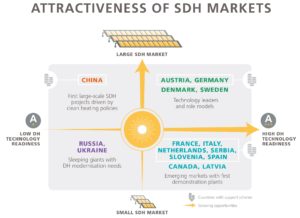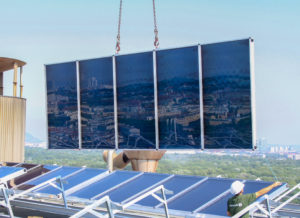New milestones on the German solar district heating market
July 21, 2023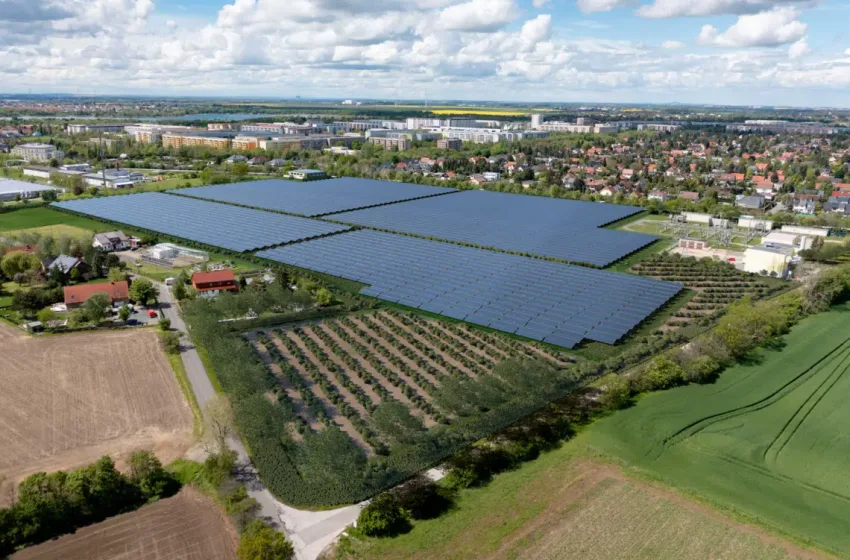
Germany was the largest solar district heating market in Europe in 2022. According to market statistics from the German institute Solites, four solar district heating plants with a total power of 24 MW started operation last year, among them the largest German plant in Greifswald with 13.1 MW. This is a big jump up from only one new plant commissioned in 2021 with 4 MW. Dirk Mangold, Head of Solites, assumes that the growth trend in grid-connected solar heat plants will continue as numerous large systems are in the planning and approval phase. Announcements of two multi-MW plants with 45.5 MW in Leipzig and 20 MW in Bad Rappenau confirm this trend. The graphic shows the 14 hectares of former agricultural land with the massive collector field in Leipzig.
Graphic: Ritter XL Solar
Solites has been tracking operating and announced SDH plants for many years and illustrates them on a map. In March 2023 this map included 49 red dots for systems in operation, totalling 102 MW (146,204 m2). Nine projects with grey dots and a total capacity of 20 MW (28,086 m2) were in the realization phase, which means that either land has already been secured or the tendering process finalized.
The national EPC project developers have a strong influence on the collector technology used. The four new German SDH systems from 2022 all consist of evacuated tube collectors because the two market leaders in this collector segment, Ritter XL Solar and Viessmann, won the recent tenders.
Denmark, the largest SDH market in Europe to date, currently has 123 systems and they are based almost exclusively on flat-plate collectors. Three of them consist partly of concentrating systems, but evacuated tube collectors have hardly been used there.
| Investor | Gross collector area [m2] | Solar thermal power [MW] | City/town | EPC collector field supplier |
| Stadtwerke Greifswald | 18,732 | 13.1 | Greifswald | Ritter XL |
| Ritter Sport | 2,312 | 1.6 | Dettenhausen | Ritter XL |
| Stadtwerke Lemgo | 9,118 | 6.4 | Lemgo | Viessmann |
| Stadtwerke Aschersleben
|
3,717 | 2.4 | Aschersleben | Viessmann |
Four new SDH plants commissioned in 2022, all using vacuum tube collectors. Source: Solites
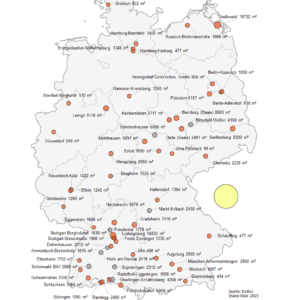
The German SDH market status March 2023: Each red dot on the map represents one of the 49 solar district heating plants that are up and running all over Germany, while the nine grey dots identify systems that are in planning or under construction. According to Solites, announcements have been made for another 66 installations totalling about 454,550 m2 (318 MW) (yellow circle). Within the yellow dot project capacities are weighted according to their probability of realization. Source: Solites
Largest SDH plant in Germany with 45.5 MW
Since the map was published in March 2023, two other large systems have entered the implementation phase. The 45.5 MW plant in Leipzig sets a new milestone as it more than triples the output of the current largest system in Greifswald. “The contract was awarded after a Europe-wide tendering procedure. Ritter was able to assert itself with its specialist knowledge and efficiency as well as the quality and technology it offered”, commented Frank Viereckl, Spokesman for the Stadtwerke Leipzig, the investor in the SDH plant.
The dimensions are impressive: The system with 65,000 m2 of collector area is to be built on an area of 14 hectares in the Lausen-Grünau district of Leipzig and will supply around 26 GWh of heat per year. This will cover around 20 % of Leipzig’s daily heat requirements in summer, according to the press release published by Ritter XL in April 2023. Solar heat will cover 2 % of the total annual heat requirement in the network. The finalization is planned for 2025.
Finding a suitable site was one of the biggest challenges
“We can manufacture the system’s collectors completely in our factory in Dettenhausen in the next year and a half without having to invest in increases in production capacity,” confirmed Christoph Bühler, Division Manager at Ritter XL Solar.
Viereckl said there were several hurdles in implementing the mammoth project, but finding a suitable area was one of the biggest challenges. In the end, the utility was lucky to be able to use the ideally suited agricultural area in Lausen. The area is right next to the district heating pipeline. The subsequent approval planning also turned out to be very complex, according to Viereckl.
Thanks to the good cooperation with the city of Leipzig, the public utility was able to create the legal basis for the planned system within two years. The tendering procedure then took place in April 2022 and a decision was made in April 2023, around 15 months later than originally planned. The delays were also due to the rapidly changing economic conditions caused by the corona pandemic and the war in Ukraine, which made a new, internal assessment necessary, explained Viereckl.
The investor attaches particular importance to the integration of the collector field in the agricultural environment. The installation height is at least 80 cm, so that species-rich seed-planting can be used and sheep can graze underneath. New hedges, perennials and fruit trees are also planned.
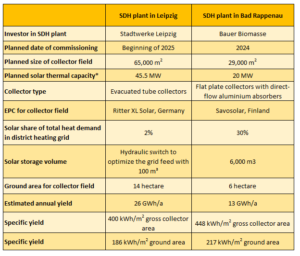
Key data for two new ordered major SDH projects with different collector types*. The conversion factor of 0.7 kW/m2 collector area was used to calculate the power. Source: Bauer Biomasse / Stadtwerke Leipzig / Ritter XL Solar
Biogas is too valuable to be used in combined heat and power plants
The second large-scale plant that was announced is special in a number of ways. It is the first order from Germany for a multi-MW system from the Finnish manufacturer Savosolar, which uses aluminium absorbers with full flow in its collectors and is part of the Meriaura Energy Group. The first SDH plant from Savosolar in Germany was Ettenheim with 1.2 MW in 2021.
In addition, the solar thermal system is dimensioned so large that it not only covers the entire hot water requirement of the connected households in the village of Bad Rappenau in southern Germany during the summer, but also provides the drying of animal feed in the factory of the investor, Bauer Biomasse. Wood and, above all, biogas are too valuable to be used to generate district heat when the sun can do it, is the motivation of company boss Markus Bauer.
He would like to convert the biogas into biomethanol in natural gas quality and definitely not use it to generate electricity in the summer. This eliminates the waste heat from the biogas combined heat and power plants during the summer months, which is to be replaced completely by solar energy in the future. In a private-sector tender, Bauer negotiated with the various SDH providers in Europe and chose Savosolar because of the favourable price-performance ratio.
Websites of organisations mentioned in this news article:
Solites: https://www.solites.de/en/
Ritter XL Solar: https://www.ritter-xl-solar.de/
Stadtwerke Leipzig: https://www.l.de/stadtwerke/
Viessmann: https://www.viessmann.family/en.html
Savosolar: https://meriauraenergy.com/
Bauer Biomasse: https://www.bauer-biomasse.de/
Aalborg CSP: https://www.aalborgcsp.de/
